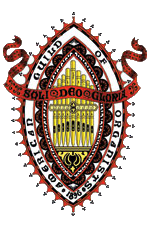Global Music on the Organ (Part 2)
Dear John,
My pastor wants me to incorporate global music into our services. We don't have a piano in the sanctuary and we have limited percussion resources, as well as the limitation of people capable to play them. Can I do these hymns on the organ?
Thank you!
World Music Wonderer
Dear World Music Wonderer,
One of the most important things to remember about the pipe organ is that, really, it’s just a bunch of flutes and reeds. I had that in my head when I was practicing the Cameroonian hymn, Louez le Seigneur!. I did a quick internet search for Cameroonian flute music and turned up this wonderful website: http://en.cezame-fle.com/liste_titres_album.php?id_album=1310
After listening to the flutists in the first example, I transposed their music:
and used it as an ostinato under which I could play the hymn tune during the hymn introduction and during an interlude before the last verse. It turned out to be a nice way to include a wider variety of Cameroonian musical material. For the hymn itself, I played it pretty much as written, on reed stops, with a very steady and deliberate pulse.
I love the Tanzanian hymn, “Gracious Spirit, Hear Our Pleading”, but I find that playing the parts from the hymnal leaves you with a hymn that sounds more like a Genevan Psalter tune than something out of East Africa. I thought back to a standard bell pattern from Ghanaian drumming (I know that Ghana isn’t really all that close to Tanzania, but it’s closer than Geneva!). I crafted a nice pedal ostinato out of the pattern,
and I used it underneath the hymn tune. For the first few verses, I used only that ostinato and the melody; coordinating it is a little tricky, and it’s nice to have the tune stated clearly for congregations not familiar with it. Remember that rhythm can trump harmony. In later verses, I might fill in some chords with my left hand.
Sometimes I don’t need to adjust what’s on the page too much. The fantastic Zimbabwean hymn Uyai Mose has a rhythmically active tune, so it can be quite effective to play what is on the page with the organ’s trumpet stops. Reeds can make rhythms clearer, and I like to think that I can approximate the sound of a Zimbabwean brass band (I did a quick internet search to determine that Zimbabwe actually has brass bands). Again, a very steady and deliberate pulse is in order; never rush music from Africa.
For our final hymn, let’s travel further east to Taiwan. Ever since I opened a copy of the new Presbyterian hymnal, Glory to God, I have been intrigued by the Taiwanese hymn “The Rice of Life.” But, what can an organist do with a hymn that has slides in the melody? It’s a quadratonic melody, so I wondered about setting up a recorded pattern of randomly played notes from the melody over a pedal of the final pitch; if you don’t have a record function on your instrument, you can even mark the keys with stickers and have a member or two of the congregation play the organ. With the organ set up to play a steady stream of pitches from the scale, I stood in front of the congregation and sang the melody with them, very slowly and deliberately, complete with bits of portamento. It’s a hauntingly beautiful hymn, and it’s terrific to support it with the organ.
Next month, we’ll look at recent American hymns composed in a folk style.
Doug Brown is Director of Music at Ginter Park Presbyterian Church, Richmond, Virginia, and at Union Presbyterian Seminary, Richmond, Virginia.


